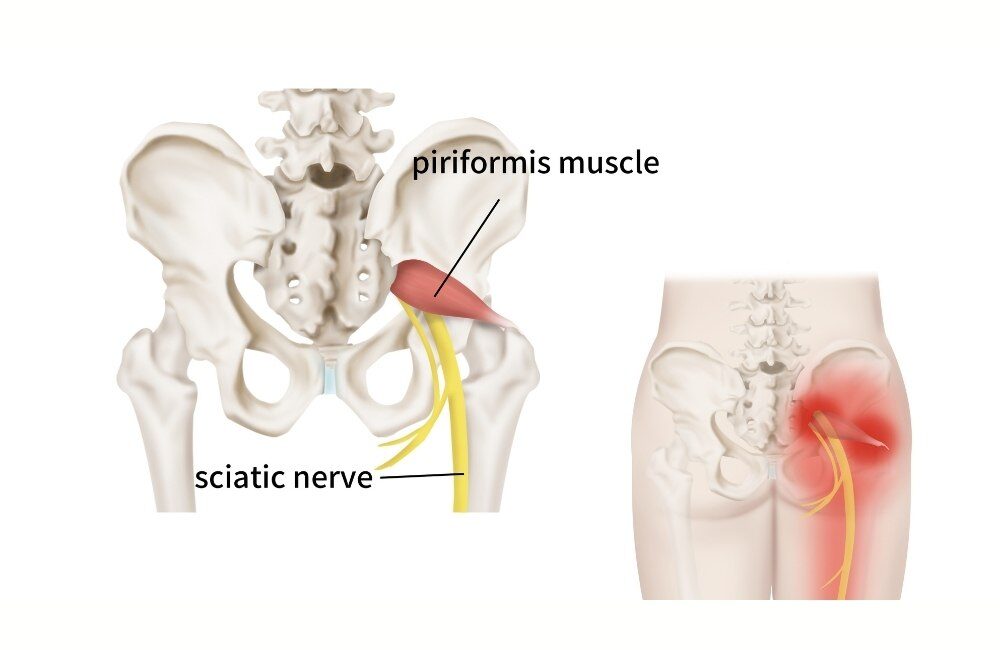Finding Comfort: How to Sit with Piriformis Syndrome and Relieve Pain
Living with piriformis syndrome can be a challenging experience, especially when it comes to sitting for extended periods. The pain and discomfort caused by this condition can significantly impact your daily activities and quality of life. However, by understanding how to sit with piriformis syndrome and implementing strategies to relieve pain, you can find the comfort you seek.
Brief explanation of piriformis syndrome and its impact on sitting
Piriformis syndrome refers to a condition where the piriformis muscle, located deep in the buttock region, becomes tight or inflamed, causing compression of the sciatic nerve. This compression can result in pain, tingling, or numbness that radiates down the leg. While symptoms may vary from person to person, sitting can exacerbate the discomfort due to increased pressure on the piriformis muscle.
Importance of finding comfort and relieving pain while sitting with piriformis syndrome
Sitting is an unavoidable part of our daily lives, whether at work, in the car, or during leisure activities. Therefore, finding ways to sit comfortably with piriformis syndrome is crucial for managing the condition and preventing further aggravation. By learning effective techniques to relieve pain and promote proper posture while sitting, you can regain control over your daily routine and experience a significant reduction in discomfort.
In the following sections, we will explore various strategies and techniques that can help you find comfort while sitting with piriformis syndrome. From understanding ergonomic principles to incorporating active sitting techniques, we will provide you with valuable insights and practical tips to alleviate pain and promote overall well-being. Remember, while these suggestions can be beneficial, it is important to consult with a healthcare professional for personalized advice and treatment options specific to your situation.
Now, let’s dive into the details and explore how you can make sitting a more comfortable experience despite having piriformis syndrome.
Understanding Piriformis Syndrome
Piriformis syndrome involves the tightening or inflammation of the piriformis muscle, located deep in the buttock region. It leads to compression of the sciatic nerve, causing pain, tingling, or numbness down the leg. When sitting, the increased pressure on the piriformis muscle can worsen the discomfort.

To effectively manage piriformis syndrome while sitting, it is essential to gain a clear understanding of the condition and its impact. By doing so, you can take proactive steps to alleviate pain and improve your sitting experience.
So, what should you know about piriformis syndrome and how it affects sitting?
Definition and causes:
- Piriformis syndrome involves the tightness or inflammation of the piriformis muscle, leading to sciatic nerve compression.
- Common causes include muscle overuse, injury, trauma, or biomechanical abnormalities.
Symptoms and challenges while sitting:
- Pain in the buttock region that may radiate down the leg.
- Tingling or numbness along the path of the sciatic nerve.
- Discomfort worsens while sitting due to increased pressure on the piriformis muscle.
The role of the piriformis muscle:
- The piriformis muscle plays a crucial role in stabilizing the hip joint and assisting with leg movement.
- Its location near the sciatic nerve makes it susceptible to compression and subsequent pain.
By developing a solid understanding of piriformis syndrome and its effects on sitting, you can approach the management of this condition more effectively. In the next section, we will explore ergonomic principles that can help you sit with piriformis syndrome comfortably and with reduced pain.
Ergonomic Principles for Sitting with Piriformis Syndrome
Achieving proper sitting posture and utilizing ergonomic principles can significantly alleviate pain and discomfort associated with piriformis syndrome. By implementing the following strategies, you can create a more supportive and comfortable sitting environment:
Maintain proper sitting posture:
- Sit upright with your back against the chair, avoiding slouching or leaning forward.
- Distribute your body weight evenly on both hips, ensuring balanced pressure on the piriformis muscles.
Choose the right chair and cushion:
- Opt for a chair that provides adequate lumbar support and promotes proper spinal alignment.
- Consider using cushions or pillows designed to relieve pressure on the piriformis muscle.
Adjust chair height and positioning:
- Set your chair height so that your feet rest flat on the floor, promoting optimal blood circulation and reducing strain on the hips.
- Position the chair at a comfortable distance from your workstation to maintain a relaxed posture.
Utilize lumbar rolls and cushions:
- Place a lumbar roll or cushion behind your lower back to support the natural curve of your spine.
- This helps relieve pressure on the piriformis muscle and promotes proper alignment.
By incorporating these ergonomic principles into your sitting routine, you can significantly enhance your comfort level and minimize the impact of piriformis syndrome. In the next section, we will explore active sitting techniques that further aid in pain relief and promote overall well-being.
Active Sitting Techniques for Pain Relief
In addition to maintaining proper sitting posture and utilizing ergonomic principles, incorporating active sitting techniques can provide further pain relief and improve your overall well-being while dealing with piriformis syndrome. These techniques involve regular movement and targeted exercises to alleviate tension in the piriformis muscle. Here are some strategies to consider:
Take regular breaks and move:
- Avoid sitting for prolonged periods without movement.
- Set reminders to take short breaks every 30 minutes or so and engage in light stretching or walking.
Perform stretching exercises:
- Incorporate specific stretches that target the piriformis muscle.
- Examples include the seated piriformis stretch, figure-four stretch, and supine piriformis stretch.

Strengthen supporting muscles:
- Strengthening exercises help improve overall posture and provide better support to the piriformis muscle.
- Focus on exercises that target the core, glutes, and hip muscles, such as bridges, planks, and clamshells.
By actively engaging in movement and exercises, you can reduce muscle tension, improve flexibility, and alleviate pain caused by piriformis syndrome. These techniques should be tailored to your specific needs and abilities. Consult with a healthcare professional or physical therapist to ensure you are performing the exercises correctly and safely.
In the next section, we will explore practical tips for sitting with piriformis syndrome in various everyday situations, such as at work, in the car, or at home.
Tips for Everyday Situations
Sitting with piriformis syndrome can be particularly challenging in various everyday situations. However, with some adjustments and strategies, you can find comfort and alleviate discomfort in different scenarios. Here are some practical tips for sitting with piriformis syndrome:
Sitting at work or in an office setting:
- Ensure your workstation is ergonomically set up with an adjustable chair, proper desk height, and supportive backrest.
- Consider using a standing desk or a desk converter to alternate between sitting and standing throughout the day.
Sitting in a car or during long journeys:
- Adjust your car seat to maintain proper posture and support for your back.
- Use a lumbar roll or cushion to provide additional support during long drives.
- Take regular breaks to stretch and walk around during extended car rides.
Sitting at home or during leisure activities:
- Choose furniture with proper support and cushioning, such as an ergonomic chair or a recliner.
- Use pillows or cushions to provide additional support and relieve pressure on the piriformis muscle.
- Incorporate short breaks for stretching or movement while engaged in leisure activities.
By implementing these tips, you can make sitting more comfortable and manageable in different settings. However, it’s important to listen to your body and adapt these strategies to your individual needs. In the next section, we will explore additional measures for pain management that can complement your sitting strategies for piriformis syndrome.
Additional Measures for Pain Management
In addition to implementing strategies for comfortable sitting, there are various additional measures you can take to manage pain caused by piriformis syndrome. These measures can provide further relief and support your overall well-being. Consider the following options:
Heat and cold therapy:
- Apply a heating pad or warm compress to the affected area to relax the muscles and improve blood circulation.
- Alternatively, use an ice pack or cold compress to reduce inflammation and numb the area for temporary pain relief.
Over-the-counter pain medications and topical creams:
- Nonsteroidal anti-inflammatory drugs (NSAIDs) like ibuprofen can help reduce pain and inflammation.
- Topical creams or ointments containing menthol or capsaicin may provide localized relief when applied to the affected area.
Seek professional help:
- Consult with a physical therapist who can design a personalized exercise program to target your specific needs.
- Chiropractic care or massage therapy may also provide relief by focusing on muscle relaxation and realignment.
It’s important to note that these additional measures should be used in conjunction with the strategies discussed earlier and under the guidance of a healthcare professional. They can complement your efforts to manage pain and promote healing.
In the concluding section, we will recap the key points discussed throughout this article and emphasize the importance of seeking professional advice for personalized treatment options.
Lifestyle Adjustments for Long-Term Relief
To experience long-term relief from piriformis syndrome and minimize the recurrence of pain, it is essential to make certain lifestyle adjustments. These adjustments can contribute to your overall well-being and support the management of piriformis syndrome. Consider the following:
Maintain a healthy weight and stay active:
- Excess weight can put additional strain on the muscles and joints, including the piriformis muscle.
- Engage in regular physical activity to strengthen the muscles, improve flexibility, and support proper posture.

Incorporate low-impact exercises and activities:
- Choose exercises that are gentle on the joints, such as swimming, walking, or cycling.
- Avoid high-impact activities that may exacerbate pain or strain the muscles.
Practice stress management techniques:
- Stress can contribute to muscle tension and increase pain levels.
- Explore relaxation techniques like deep breathing, meditation, or yoga to help reduce stress and promote muscle relaxation.
By adopting a healthy and active lifestyle while managing stress levels, you can provide a solid foundation for long-term relief from piriformis syndrome. Remember, consistency and moderation are key.
In the concluding section of this article, we will summarize the key points discussed and emphasize the importance of seeking professional advice for personalized treatment options and guidance.
Conclusion
In conclusion, sitting with piriformis syndrome can be a challenge, but with the right strategies, you can find comfort and relieve pain. Understanding the condition and its impact on sitting is crucial in managing piriformis syndrome effectively.
By implementing ergonomic principles, such as maintaining proper sitting posture, choosing the right chair and cushion, and utilizing lumbar support, you can create a more supportive sitting environment.
Incorporating active sitting techniques, including regular breaks, stretching exercises, and strengthening exercises, helps relieve tension in the piriformis muscle and promote better posture.
Additionally, practical tips for everyday situations, such as at work, in the car, or at home, can further enhance your sitting experience and minimize discomfort.
Consider additional measures like heat and cold therapy, over-the-counter pain medications, and seeking professional help through physical therapy or chiropractic care for effective pain management.
Remember, lifestyle adjustments, including maintaining a healthy weight, engaging in low-impact exercises, and practicing stress management techniques, contribute to long-term relief from piriformis syndrome.
While these strategies are helpful, it is important to consult with a healthcare professional for personalized advice and treatment options tailored to your specific needs.
With the right approach and a proactive mindset, you can find comfort, relieve pain, and regain control over your sitting experience with piriformis syndrome.

